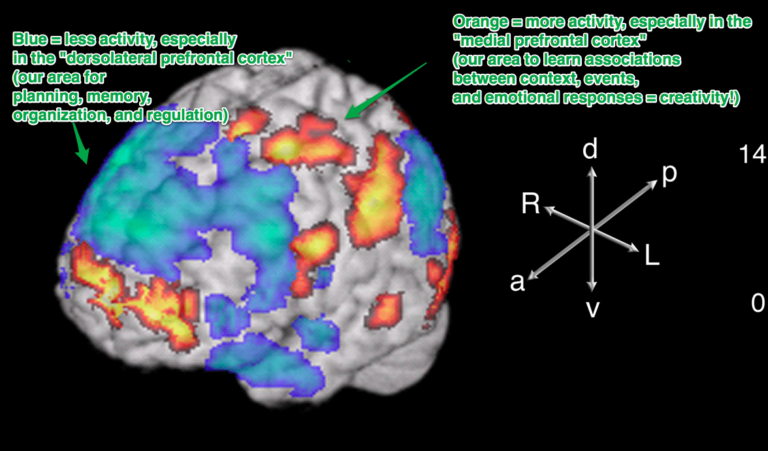Can technology use affect our creative and lateral thinking abilities?
There is a common misconception, based on research done on split-brain patients in the 1960s, that creativity and analytical thinking activities are either right- or left-hemisphere brain functioning. We often talk about people being either creative or analytical, implying a dominance of either the right or left side of their brain. This thinking has been challenged by creativity research conducted since the 1980s. But the outdated myth has become entrenched as a worldview, an overarching narrative about how we work, and a subconscious bias towards the creative ability of both ourselves and others. We are all creative, we just don’t always realise it, or label it as such.

Research on freestyle wrappers indicated that it was necessary for the brain to attenuate (i.e. subvert) the analytical regions in order for the creative regions of the brain to be able to activate and form creative ideas. Both analytical and creative regions could be found on the right and left sides of the brain. This is why we have so many great ideas in the shower, on a walk, or at times we are not distracting ourselves with our cognitively demanding activities or our technology. Research done by Bluhm, R. et al in 2009 demonstrated that when we are bored the central part of our brain lights up. This means that the more distracted we are, the less likely we are to engage in types of self-reflection, or reflection of any kind for that matter.
A creative idea is defined by Alice Flaherty as ‘one that is both novel and useful (or influential) in a particular social setting’. If our attention is focused on a screen or the analytical part of our brain is distracted or engaged in wrestling with a problem to solve, it seems it isn’t possible to have creative ideas or be able to make lateral thinking connections.
Our ability to be creative has fascinated me for quite some time. During my corporate marketing days, with a growing sense of irony, I noticed that an analytical mindset was considered to have greater value than a more creative mindset. When there was discussion around ‘being creative’, what seems to have been implied was the ability to think laterally, rather than creatively. Additionally, there seemed to be an underlying thinking that (if DeBono was correct) lateral and divergent thinking skills were teachable. For some reason, this didn’t quite make sense to me. I had always assumed that creative, divergent and lateral thinking ability was inherent in everyone. I also believed that creativity and artistic ability weren’t always correlated – in the same way as all squares are rectangles, but not all rectangles are squares.
In reviewing research literature, I discovered that those who have more of the Openness Personality Trait are more likely to be creative. However, I couldn’t find any previous research that focussed on the link between Lateral Thinking and personality traits. So, as part of my final psychology degree dissertation, I sought to understand if there was a specific type of person who had a greater ability to think laterally and was, therefore, someone that could be more ideally suited to a ‘creative’ role or career than others.
What my research study suggested is that although there did indeed seem to be a correlation between personality and creativity, there was no correlation between personality and lateral thinking skills. This could be because lateral thinking questions used in research are often based on the ability of a person to solve a puzzle by drawing on associations with their past lived experience. E.g. one of the questions is: Five pieces of coal, a carrot and a scarf are lying on the lawn. Nobody put them on the lawn but there is a perfectly logical reason why they should be there. Why is that? The answer is: They were used to make a snowman, which has now melted. The question assumes the reader has grown up where it snows during winter, and they have had the experience of building snowmen using carrots and coal for their facial features. Another question is: A man pushed his car. He stopped when he reached a hotel at which point, he knew he was bankrupt. Why? The answer is: He was playing Monopoly. If someone has never played Monopoly in the past, they would never be able to come up with that answer.
What the research suggested is that lateral thinking ability is directly linked to age. The more life experience a person has, the greater ability they have to make connections between seemingly random pieces of information to solve a unique puzzle.
Going back to how this creativity and lateral thinking are related to technology? The reality could be that spending more time online or staring at a screen, can limit our ability to engage in alternative lived experiences. It also limits the time our brain has to engage in free association while not distracted or thinking analytically. This can potentially lead to lower levels of creative time and possibly a sense of creative ability. The less experience we have at being creative and thinking laterally, the less creative we think we are and the lower the chances are that we will give ourselves the freedom to recognise that we are by nature creative and allow ourselves to engage in more creative tasks.
Links to a few other articles and podcasts on being creative are available below:



